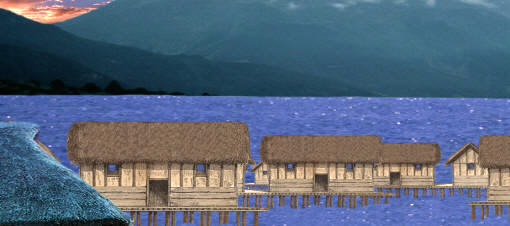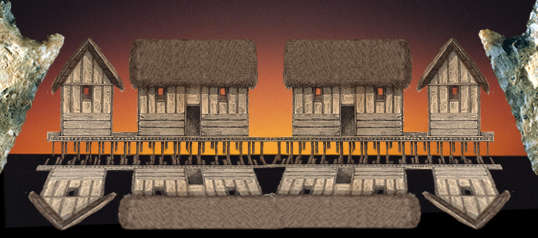|
"One hundred and
fifty years ago, as a result of a dry and harsh winter, the water level
of Lake Zurich decreased considerably, exposing ancient remains of
lacustrine (found on or in a lake)
villages. The chance discovery-----triggered what we now call the
"lake-dwelling phenomenon."---2004,
Francesco Menotti,
"Living On The Lake In Prehistoric Europe, 150 Years Of Lake-Dwelling
Research," p. 1.
"The first recorded discoveries of
Lake-Dweller antiquities took place at Ober-Meilen on Lake Zurich as
long ago as 1829, but it was not until 1854, at a time of extremely low
water, that implements and upright piles were found in sufficient
quantities to impress their significance upon the finders, who were
workmen and lake-front property holders trying to reclaim some of the
dry beach."---1921, N. C. Nelson, "Swiss
Lake-Dweller Discoveries," Natural History, Vol. XXI,
March-April issue,
p. 174.
"It has
long been known to the inhabitants upon the shores of the Swiss lakes
that there existed in many of them ancient posts or piles, which without
reaching the surface, rose to a height of 30 or 60 centimeters above the
bottom. On Lake Neuchatel they were especially known to the fishermen,
who dreaded them as a cause of injury to their nets."---1872,
E. Desor, "Palafittes Or Lacustrian Constructions, Of The Lake Of
Neuchatel," Annual Report of The Smithsonian Institution, p. 349.
"In 1868 a correction to the lake levels was
made, to prevent the regular flooding----. ----the lakebeds were
exposed. The 'harvest time of archaeology' had begun, but described by
others as 'a chaotic treasure hunt.' Fishermen abandoned the fish and
took to antiquity, and dealers abounded"---1989,
Bryony and John Coles, "People Of The Wetlands, Bogs, Bodies and
Lake-Dwellers," p. 25.
"In localities where--(artifacts
are laying on the surface of the lakebed)--and where, strange to say, these primeval antiquities appear still on
the surface of the lake bottom after having been exposed for thousands
of years to the gaze of every boatman who passed over them, all that is
required is a keen eye, clear still water, and a pair of forceps---."---1866,
Dr. Ferdinand Keller, "The Lake Dwellings Of Switzerland And Other
Parts Of Europe," p. 9.
"Their
principal characteristic (referring
to Lake-Dwelling site artifacts) is
more the exceptional preservation of the organic remains than the nature
of the construction, whether they rested on piles or low sand banks, or
whether they were built on the shoreline, on a lake-edge platform, or
directly over the waters of the lake."---1996,
Brian M. Fagan, "Lake Dwellings, European," The Oxford
Companion To Archaeology, p. 381.

SWISS LAKE DWELLERS
SWITZERLAND
NEOLITHIC AND BRONZE AGE
Mention Swiss Lake Dwellings and "organic preservation" immediately
comes to mind. That's because the preservation really is extraordinary.
Especially the
stone tools that are still attached to their thousands of years old wood
and antler handles and hafting sockets. They represent some of the most
recognizable artifact forms in the world. Before the
discovery of the Swiss lake sites very little was known about
the ancient cultures who once lived in this region. But once the
discovery was made there began a tremendous drive to collect and
excavate the lake sites.
|
|
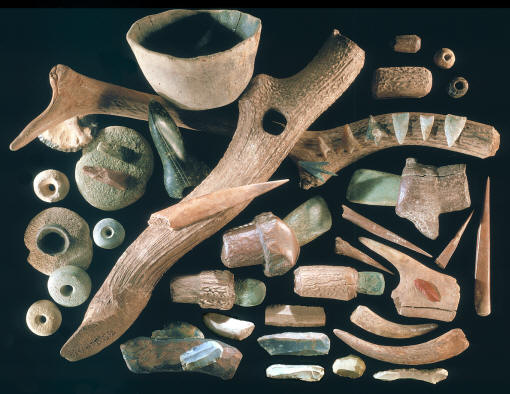
PRIVATE COLLECTION
CLICK ON PICTURE FOR LARGER IMAGE
MISCELLANEOUS TOOLS FROM LAKE SITES
SWITZERLAND
NEOLITHIC & BRONZE AGE
This picture shows
some of the different types of tools that have been found of Swiss
Lake Dwelling sites (except for the large
antler axe). Most date to
the Neolithic period. The rest would date to the Bronze Age. The
bone and antler preservation is immediately apparent. Lake dweller
sites are known world wide for their extraordinary examples of all
things organic, especially the hafted stone tools that have wooden
handles.
The antler pick and antler axe are the largest artifacts in
this picture. Other bone and antler tools are
identified as awls,
beads, sockets, flaking tools and a chisel.
Unfortunately the antler axe is the
only artifact that does not have a provenience. It was originally in
a large collection in Denmark and probably originates from that
area. It measures 17 5/8 inches (44.7 cm) long and it has a
circumference of 6 3/8 inches (16.2 cm). The blade width is 2 1/8
inches (5.3) cm wide. The antler pick was found on the Auvernier site on
Lake Neuchatel in western Switzerland.
It measures 18 3/4 inches (47.6 cm) long. Two of the tines and the
base of the antler were removed by grooving and snapping.
The stone artifacts in this picture are identified as
arrow points, celts, scrapers, sickle blades, net sinkers, spindle
whorls, a graver and a battle axe. The battle axe is broken but the
green serpentine stone it was made from is especially nice. The
arrow points are stemmed and triangular types.
Several of the celts are shown as they were once hafted into their
antler sockets. One of the sickle or side blades is hafted onto a
modern replica of a wooden handle (bottom
left side). Similarly hafted
tools have been found on lake dweller sites.
Two complete ceramic pots can also be seen in this
picture. Both were found on the Auvernier site. The small miniature
pot, at left side, may have been a child's toy. The larger pot is
plain and
It measures 5 3/8 inches (23.6 cm) in diameter and 3 1/4 inches (8.2
cm) high.
A Bronze Age metal arrow point is laying on one of the antler
tools. It was found at Fallanden on Lake Greifensee.
|
|
|
Up until the mid
ninetieth century there had been discoveries of well preserved antler,
bone and wood artifacts in other European countries. But wetlands
archaeology was born in Switzerland. Contained within its boundaries are
many lakes, the largest of which are Lake Geneva and Neuchatel in the
west and Lake Zurich in the northeast. These lakes have produced the
overwhelming majority of all early lake dwelling site
artifacts. |
|
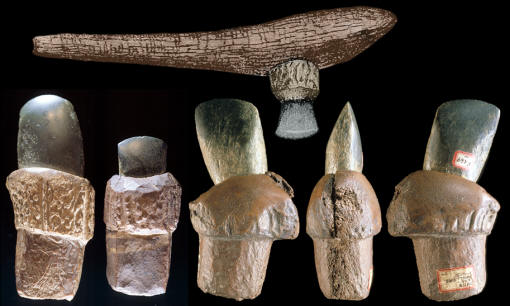
CLICK ON PICTURE FOR LARGER IMAGE
OF AXE AT RIGHT
ANTLER SOCKETED CELTS
SWITZERLAND
NEOLITHIC
This
picture shows three different antler hafted celts. The three on the
right is the same example showing three different sides. Antler
socketed celts are probably the most famous tool type found on Swiss
lake dwelling sites. The drawing of the axe above illustrates how
they were fitted onto a wooden handle. The antler sockets serve as shock absorbers to protect the handle from splitting. The
antler/celt assembly on the right measures 4 7/8 inches (11.7 cm)
long.
In the United States, antler sockets have been found on the
Cushing site at Key Marco in Florida. They were hafted as adzes
rather than axes. |
|
|
The earliest documented lake dweller site discovery in
Switzerland occurred in 1829 at the town of Meilen on Lake Zurich.
During a dredging operation wooden piles and various types of Neolithic
artifacts were found but the discovery wasn't reported and its
significance wasn't recognized until many years
later. |
|
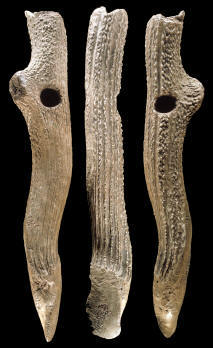 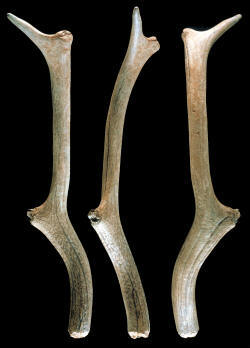
CLICK ON PICTURE FOR LARGER IMAGE
ANTLER AXE AND ANTLER PICK
AXE
DENMARK & AUVERNIER SITE,
SWITZERLAND
The antler axe on the left has no
provenience and may not have been found on a lake site. This
exceptionally large antler axe was possibly discovered in
Denmark, where it was originally part of a large collection of
Neolithic period artifacts. Antler axes and adzes are found on
Swiss Lake Dwelling sites but they average in size much smaller
than this example. The position of the hole in relation to the
bit determines whether it was once hafted as an axe or adze.
Mathiassen reports that the blade is
formed by oblique cutting and may be in line with the
perforation or at right angles to it. He also reports that most
examples from Denmark measure somewhere between 5 7/8 to 7 7/8
inches(15 to 20 cm) long. This antler axe measures 17 5/8 inches
(44.7 cm) long and it has a circumference of 6 3/8 inches (16.2
cm).
The antler artifact on the right was found on the Auvernier site on
Lake Neuchatel in western Switzerland. Mathiassen describes a
similar example from Denmark as a pick axe. The beam forms the
handle and a tine the point.
Two of the tines and the base of the
antler were removed by grooving and snapping.
This example is fairly large.
It measures 18 3/4 inches (47.6 cm)
long. |
|
|
Twenty four years after the 1829 discovery, a drought in 1853 caused the
waters to recede in Lake Zurich. The local property owners began to
reclaim some of the lakeshore land by dredging the mud. They discovered
large numbers of artifacts and more of the wooden piles. This time the
discovery was brought to the attention of Dr. Ferdinand Keller. It was
at this time that a dramatic period of collecting and excavation
began. |
|
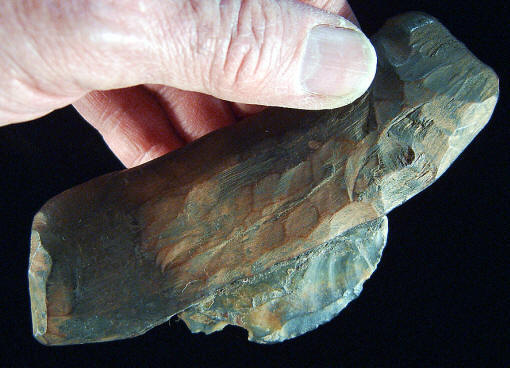
BLADE HAFTED ONTO REPLICA
HANDLE
SWITZERLAND
This picture shows a blade hafted
onto a replica wooden handle. Similar cutting tools like this
example have been found on lake-dwelling site. |
|
|
Dr. Ferdinand Keller was the President of the Antiquarian Association of
Zurich. He was the first to publish in September 1854 and interpret the
discoveries of Neolithic and Bronze Age Lake dweller sites. As soon as
the discovery of these extremely well preserved sites became known there
was a frenzy of activity. People began to comb the lakes for more sites.
Fishermen, who in years past had damaged their nets on underwater wooden piles, were sought out
for possible locations of new sites. In fact, the fishermen had always
known about the lake sites and the artifacts that could be found around
them. By the early 1860's over a hundred sites had been reported. |
|
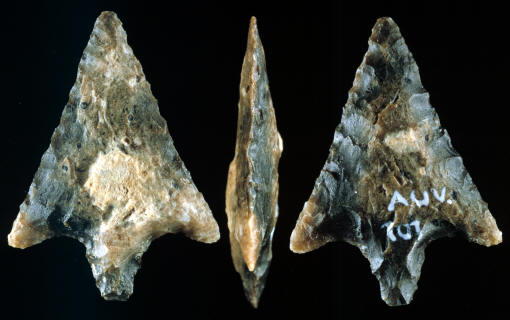
CLICK ON PICTURE FOR LARGER IMAGE
STEMMED ARROW POINT
AUVERNIER SITE, LAKE NEUCHATEL
WESTERN
SWITZERLAND
NEOLITHIC
This arrow point was found on the Auvernier
site in western Switzerland. It's a classic example of a common form
of projectile point that is found on Stone Age sites in many areas
of the world. Keller illustrates three different shapes of arrow
points and refers to this style as "the most artistic of all."
Desor also describes lake dweller arrow points in 1872: "The arrows
are triangular, frequently provided with barbs, which rendered them
more formidable. Traces are sometimes observed of the cement which
united them to the stock. There were also points of arrows of bone,
but these are much rarer; the museum of Neuchatel posses one from
Concise of very peculiar form; others were fitted to the stick and
secured by means of pitch. In the specimen annexed (pictured)
may be distinguished the impression of the stick and the thread
which fastened it; others still are serrated, or furnished with a
small lateral hook, similar to a diminutive harpoon." He also
reports that the bows were made of yew and that they had found them
in good preservation.
This
point is made from good quality chert and it measures 1 5/16 inches
(3.3 cm) long. |
|
|
An early example of the collecting mania occurred, beginning in 1868
near Lake Neuchatel with a flood prevention project that eventually
lowered water levels as much as 6 to 8 feet (2 to 2.5 m). The effects of
the project lasted until 1888 as more and more of the lakebed was left
exposed. This period is described as "the harvest time for archaeology"
and by others as "a chaotic treasure hunt." Coles writes that "Fishermen
abandoned the fish and took to antiquity, and dealers abounded." |
|
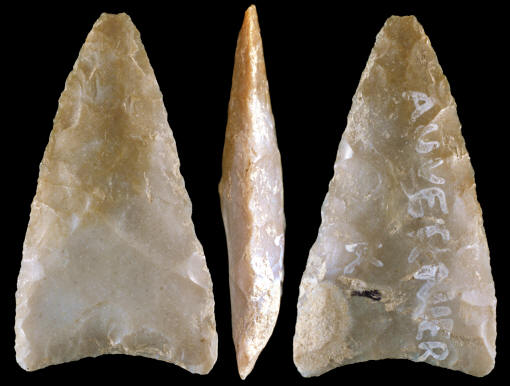
CLICK ON PICTURE FOR LARGER IMAGE
TRIANGULAR ARROW POINT
AUVERNIER SITE, LAKE NEUCHATEL
WESTERN
SWITZERLAND
NEOLITHIC
This triangular arrow point was found on the
Auvernier site in western Switzerland. Keller
describes this style of point as"---always made very sharp on the
lowest or narrowest side of the triangle, to allow of its being
fixed more easily into the cloven end of the shaft." This point is
made from good quality yellow and gray chert and it measures 1 1/16
inches (2.6 cm) long |
|
|
During the later half of the ninetieth century the Swiss government
stepped in and attempted to restrict any excavations or recovery of lake
site objects. But attempts to stop the wholesale collecting didn't seem
to help as the sale of artifacts continued. However, some of the largest
excavating projects were shut down and only small excavations were
permitted. Collecting was difficult to control because the water levels
continued to drop over a period of several years. In some areas boats
were constantly anchored over the shallow underwater sites in search of
artifacts. |
|
CONTINUE ON TO PAGE
TWO |
|
"REFERENCES"
1866,
Keller, Ferdinand, "The Lake Dwellings Of Switzerland And Other
Parts Of Europe," p. 9, 153-155.
1872, Desor, E., "Palafittes Or Lacustrian Constructions, Of The Lake Of
Neuchatel," Annual Report of The Smithsonian Institution, p. 349.
1946, Mathiassen, Therkel, "Danish Antiquities," pp. 62-63 &
64.
1975,
Marion Spjut Gilliland, "The Material Culture Of Key Marco Florida,
pp. 137 & 140.
1980, Hardin, A. F., "The Lake Dwellings Of Switzerland Retrospect
And Prospect," University Of Edinburgh Department Of Archaeology,
Occasional Paper, No. 5, p. 1.
1983, Kraft, Herbert C. & DeCicco, Gabriel, "The Search For
Humanity's Roots," p. 49.
1989,
Coles, Bryony and John, "People Of The Wetlands, Bogs, Bodies and
Lake-Dwellers," pp. 17-31.
1996,
Brian M. Fagan, "Lake Dwellings, European," The Oxford
Companion To Archaeology, pp. 381-381.
2004, Menotti, Francesco, "Living On The Lake In Prehistoric
Europe, 150 Years Of Lake-Dwelling Research," p. 1.
2004, Ruoff, Ulrich, "Lake-Dwelling Studies In Switzerland Since
'Meilen 1854,' Living On The Lake In Prehistoric
Europe, 150 Years Of Lake-Dwelling Research, pp. 9-21.
2004, Schibler, Jorg, "Bones As A Key For Reconstructing The
Environment, Nutrition And Economy Of The Lake-Dwelling Societies," Living On The Lake In Prehistoric
Europe, 150 Years Of Lake-Dwelling Research, p. 149.
2007, Lewis, Helen, "Pile Dwellings, Changing Lake Conditions And
Sediment Deposition: Preliminary Soil Micromorphology Study Of Cultural
Deposits From Underwater Sites At Lake Luokesas, Moletai Region,
Lithuania," Journal Of Wetland Archaeology, Vol. 7, pp. 33-50.
|
|
RECENT
LISTINGS HOME
ORDERING |
